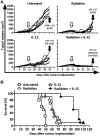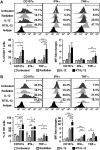Combination of radiation and interleukin 12 eradicates large orthotopic hepatocellular carcinoma through immunomodulation of tumor microenvironment
- PMID: 30228946
- PMCID: PMC6140549
- DOI: 10.1080/2162402X.2018.1477459
Combination of radiation and interleukin 12 eradicates large orthotopic hepatocellular carcinoma through immunomodulation of tumor microenvironment
Abstract
Immunotherapies have shown promising results in certain cancer patients. For hepatocellular carcinoma (HCC), the multiplicity of an immunotolerant microenvironment within both the tumor, and the liver per se may limit the efficacy of cancer immunotherapies. Since radiation induces immunogenic cell death and inflammatory reactions within the tumor microenvironment, we hypothesized that a combination therapy of radiation and lasting local immunostimulating agents, achieved by intratumoral injection of an adenoviral vector encoding interleukin 12, may reverse the immunotolerant microenvironment within a well-established orthotopic HCC toward a state favorable for inducing antitumor immunities. Our data showed that radiation and IL-12 combination therapy (RT/IL-12) led to dramatic tumor regression in animals bearing large subcutaneous or orthotopic HCC, induced systemic effect against distant tumor, and significantly prolonged survival. Radiation monotherapy induced tumor regression at early times but afterwards most tumors regained exponential growth, while IL-12 monotherapy only delayed tumor growth. Mechanistic studies revealed that RT/IL-12 increased expression of MHC class II and co-stimulatory molecules CD40 and CD86 on tumor-infiltrating dendritic cells, suggesting an improvement of their antigen presentation activity. RT/IL-12 also significantly reduced accumulation of tumor-infiltrating myeloid-derived suppressor cells (MDSCs) and impaired their suppressive functions by reducing production of reactive oxygen species. Accordingly, tumor-infiltrating CD8+ T cells and NK cells were significantly activated toward the antitumor phenotype, as revealed by increased expression of CD107a and TNF-α. Together, our data showed that RT/IL-12 treatment could reset the intratumoral immunotolerant state and stimulate activation of antitumor cellular immunity that is capable of eliminating large established HCC tumors.
Keywords: MDSC; Orthotopic HCC; combination therapy; immunomodulation; immunotherapy; radiotherapy; tumor microenvironment.
Figures







References
Publication types
LinkOut - more resources
Full Text Sources
Other Literature Sources
Research Materials
